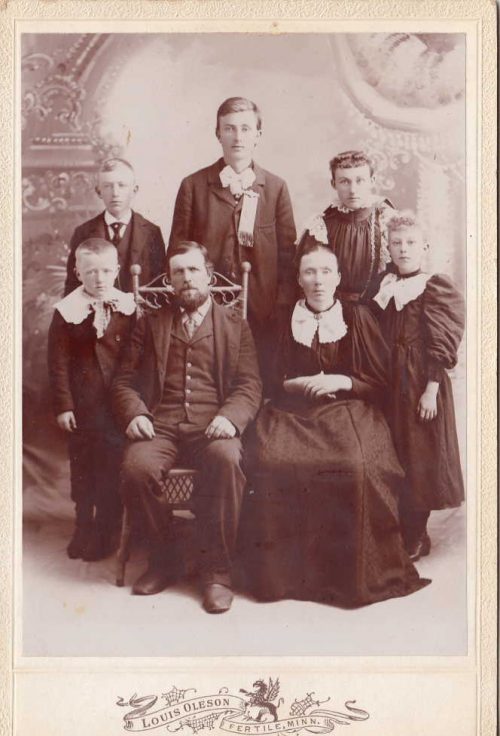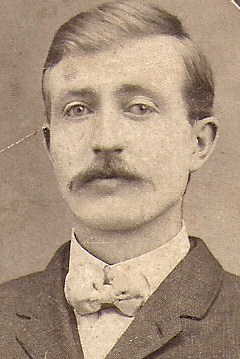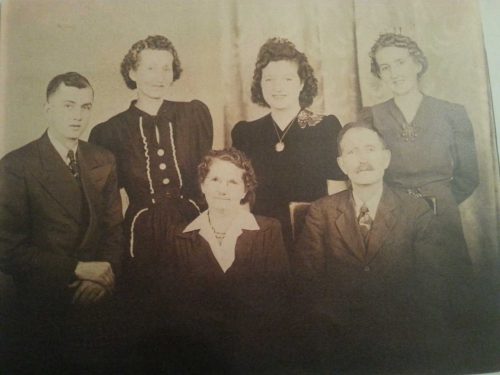I was just thinking that it was a strange coincidence that my ancestors, at least well back into the early 19th century, were all farmers and carpenters and such living here, in Western Minnesota, and that my grandfather had left this cold frigid place for the West coast after WWII, where I was born…and now I’ve ended up right back here. Well, almost — my grandparents and great grandparents and great-great grandparents etc. all lived even further north, on the flat basin of old Lake Agassiz, where the prairie was utterly flat and the winter winds could howl across the farm unimpeded by pesky hills. Then I stumbled onto a small collection of old photos.
Here’s my great-great-grandfather, Jens Westad. No, I never met him. The photo has to be from some time around the turn of the century.
I very much like the formal style. The really tall kid in the back is my great-grandfather, Peter Westad. I did know him, visited him fairly often, did chores like weeding his garden for him, but he died when I was 13. He was a handsome man, with a lovely thick mustache.
I think that photo would have been taken in his mid-twenties, maybe around 1906 when he married my great-grandmother, who was also wonderful and could make an excellent pie or fishhead soup. Here she is in a family portrait.
This one must have been taken sometime in the 1930s, before my grandfather, the young man on the far left, got shipped off to the far Pacific islands to build runways for the army.
I think that sometime this summer I should take a few days to visit the north country up around Gary and Fertile Minnesota since I seem to have fairly deep roots in that region. Not that anyone would remember the Westads, or that anything is left of their residence — damn, but we humans are impermanent — but it would just be nice to see a bit of the land that shaped my family.
Also…spider collecting trip!





I wish someone would have told us kids of the importance of knowing our family history, maybe not at the moment but later, when you’re older, presumably wiser. Being kids, we probably would have scoffed and then ran off to play with our army men but maybe some synapses could have formed All my great grandparents were gone when I was born and my paternal grandfather died when I was a toddler, my paternal grandmother when I was 6 or 7. My other grandparents were around well into my post-college young adulthood but I regret never having had conversations with them about their memories. Now all that is lost. I have a few pictures but nothing more.
Strong family likeness. That’s not very common, the way people get recombined wilson-nilson. He looks like you and your boy.
Sorry for being an overly curious stranger, but now I’m trying to mentally piece together your very interesting family history.
I recall from some earlier musing that this must be your maternal grandfather? And your mother (who probably was a teen at the time) is all Scandinavian ancestry? Since you mention early 19th century, how early did Scandinavian settlement in Minnesota begin anyway? Or white settlement generally, aside from a few 18th century French fur traders?
My mother was 6 when she left Minnesota. She scarcely remembers the place. She is a straight-up purebred Scandinavian princess.
My genealogical aunt (everyone has one of those, right?) had some records that I might still have around here. I come from a long line of Norwegian bachelors, many generations of whom right back into the early 19th century, who lived in the really cold, empty part of this state. It seems that every generation imported a bride from Sweden, so I’m the product of chain migration.
I’m curious about the Scandinavian settlement, too. It seems to have been a hard life in isolated, tiny farming communities for many generations.
Thanks, PZ. I assume you mean Red River valley in the northwest. I dug up this Wiki article I’d seen sometime earlier:
https://en.wikipedia.org/wiki/Red_River_Colony
AFAIK the southern/upstream part of this region was ceded by British to the US in 1818 (the rest later became Manitoba). The article implies that by then there was at most a handful of French/Metis settlers in the southern part. I think in 1818 there was already some Anglo-American pioneer settlement in Upper Mississippi/Minnesota River area. (IIRC you mentioned once that your father comes from this old English-speaking mixed origin pioneer stock that reached the plains around 1800 and Seattle area around 1850.)
I thought Swedish/Norwegian emigration to the US frontier only started “in earnest” after the famine of late 1860s, though some may have occurred decades earlier. The Wiki suggests that by 1870 there was substantial white settlement and wheat farming in Manitoba, and presumably also in the US portion of Red River valley.
Right. There were multiple waves, summarized in this article. I think the Westads would have arrived in the first wave, but there was a whole series of new immigrants added to the family over the next 50 years.
A lot of it was to maintain Scandinavian culture and languages for quite some time — my great-grandfather had a distinctive accent and Norwegian and Swedish memorabilia all over his house, even if his family had been here for a hundred or more years and English was his primary language. I keep that in mind when I see all the Central American families moving in. They get to keep their culture, too. It’s the American way.
I was very lucky to save a few old family photos I rescued when my father had a mad clean out when he moved into a retirement unit but we lost a lot. I have a photo of my paternal great grandfather and great grandmother and he has a magnificent moustache which i am trying to emulate. Great grandfather came to Australia from Ireland in the late 19th century. He sailed on the Samuel Plimsoll, a migrant ship named after the man of Plimsoll line fame. My great grandmother, also of Irish descent was born in a tent on the Turon goldfields about 120 miles west of Sydney. His diary with a detailed account of his voyage and his later battle with a bigoted employer along with great grandmother’s household accounts book was found hidden in the fireplace mantel of their old family home during renovations. It is now in the historic documents section of the state library. There are more photos and a much more detailed history from my mothers side. You don’t think much will be left of what was around in your great great grandparents time but you might be surprised. We have a photo of my maternal great great grandmother outside her cottage in Cornwall. A few years ago my sister visited Cornwall and found the house still standing and owned by a distant cousin. My mother was born on the West Australian goldfields and about 3 years ago while visiting my cousins in Perth I went to the Maritime Museum and found the figurehead of the Samuel Plimsoll on display. After its life as a migrant ship ended it was used as a collier on the east coast then sailed to western Australia where it hauled coal and timber. It ended its life as a floating storage depot until it was sunk when another ship collided with it.
I hope you’re storing those in archival conditions.
Some deterioration is inevitable, so I’ve scanned a bunch of photos at high resolution for possible digital restoration. Some recommendations only suggest files large enough to print out a reasonable facsimile of the original image, but I like to drill down and capture discoloration and the surface condition of the medium, because I can’t help myself.
Interesting to have some representations of the history of photographic processes too. Albumen cartes de visite were passed around like business or calling cards and are a fun look into the past.
I have some old pictures of my family from about the time as yours.
I have some relatives that helped found Winona Minnesota. I read some where that a school in Winona put a play together on the founders of Winona. I am amused thinking of elementary kids playing the parts of my relatives.
Thanks, that article will be very interesting once I have time to read it all.